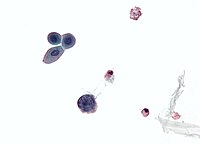
Photo from wikipedia
INTRODUCTION Fine needle aspiration biopsy (FNAB) is a minimally invasive modality to evaluate salivary gland neoplasms and help guide clinical management. However, significant overlap in the cytomorphology findings among salivary… Click to show full abstract
INTRODUCTION Fine needle aspiration biopsy (FNAB) is a minimally invasive modality to evaluate salivary gland neoplasms and help guide clinical management. However, significant overlap in the cytomorphology findings among salivary gland neoplasms often renders the definitive diagnosis challenging. Recently, a number of benign and malignant salivary gland tumors have been characterized by specific chromosomal aberrations detectable using fluorescence in situ hybridization (FISH) testing. In the present study, we evaluated the role of FISH testing performed on cytology cell blocks in the diagnosis of salivary gland neoplasms by FNAB. MATERIALS AND METHODS The data from 57 cases of primary salivary gland tumors diagnosed using FNAB at our institution and sent for ancillary FISH testing between 2012 and 2017 were retrospectively reviewed. The FISH studies were performed on cytology cell blocks, and break-apart probes were used to detect characteristic gene rearrangements for PLAG1, MYB, MAML2, and ETV6 for pleomorphic adenoma, adenoid cystic carcinoma, mucoepidermoid carcinoma, and secretory carcinoma (mammary analogue secretory carcinoma), respectively. Of the 57 cases sent for FISH testing, 6 were excluded because of FISH analysis failure (insufficient cell block cellularity). RESULTS Of the 51 cases included in the analysis, 15 samples were successfully subclassified after FISH testing, and 10 of these 15 FISH-positive cases were diagnostically confirmed by the surgical pathology review of excision material. Forty cases overall had undergone subsequent excision with the histopathologic follow-up diagnosis available, and all subclassified cases had concordant FNAB, FISH, and excision diagnoses. CONCLUSIONS FISH testing performed on cytology cell blocks is a useful adjunct in establishing the diagnosis of salivary gland neoplasms by FNAB.
Journal Title: Journal of the American Society of Cytopathology
Year Published: 2019
Link to full text (if available)
Share on Social Media: Sign Up to like & get
recommendations!